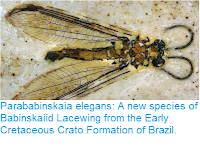The Dustrywings, Coniopterygidae, are small (usually under 5 mm) Insects related to Lacewings and Ant-lions. They are numerous and widespread, being found in woodland all over the world, where they feed on small Arthropods, such as Mites, Aphids and Scale Insects, living on trees and shrubs. Largely because of their affinity for woodland and small size, they have an excellent fossil record, with the group appearing in the Late Jurassic and specimens preserved in amber being found across much of the globe from the Cretaceous onwards.
In a paper published in the journal ZooKeys on 5 March 2019, Dominika Ružičková of the Department of Zoology at Charles University, André Nel of the Institut de Systématique, Évolution, Biodiversité at the Muséum national d’Histoire naturelle, and Jakub Prokop, name two new species of Dustywings from Cretaceous Burmese Amber.
Middle Cretaceous ‘Burmese Amber’ has been extensively worked at several sites across northern Myanmar (though mostly in Kachin State) in the last 20 years. The amber is fairly clear, and often found in large chunks, providing an exceptional window into the Middle Cretaceous Insect fauna. This amber is thought to have started out as the resin of a Coniferous Tree, possibly a Cypress or an Araucaria, growing in a moist tropical forest. This amber has been dated to between 105 and 95 million years old, based upon pollen inclusions, and to about 98.8 million years by uranium/lead dating of ash inclusions in the amber.
The first new species is named Mulleroconis hyalina, where ‘Mulleroconis’ means ‘Müller’s dust’ in honour of Patrick Müller, who collected the specimen from which the species is named from the Hukawng Valley in Myanmar and donated it to the Museum für Naturkunde in Berlin, and ‘hyalina’ means 'glassy' in reference to the appearance of the wings. The species is described from a single male specimen 1.17 mm in length, preserved within a piece of pale-yellow transparent amber. The head of this specimen is poorly preserved, the abdomen large and the legs slender. The forewings are about 1.46 mm long and 0.65 mm wide, while the hindwings are about 1.25 mm long and 0.55 mm wide.
Mulleroconis hyalina. (A) Specimen in dorsal view. (B) Detail of wing venation. Scale bar is 100 μm. Ružičková et al. (2019).
The second new species is named Palaeoconis azari, where ‘Palaeoconis’ means ‘ancient dust’ and ‘azari’ honours palaeoentomologist Dany Azar of the Lebanese University. This species is named from a single male specimen 1.93 mm in length preserved within a piece of transparent yellow amber. This specimen has well developed compound eyes and antennae with 21 segments. The abdomen is large and broad, the legs long and slender. The forewings are about 2.19 mm long and 0.93 mm wide, the hindwings about 2.12 mm long and 0.54 mm wide.
See also...
The second new species is named Palaeoconis azari, where ‘Palaeoconis’ means ‘ancient dust’ and ‘azari’ honours palaeoentomologist Dany Azar of the Lebanese University. This species is named from a single male specimen 1.93 mm in length preserved within a piece of transparent yellow amber. This specimen has well developed compound eyes and antennae with 21 segments. The abdomen is large and broad, the legs long and slender. The forewings are about 2.19 mm long and 0.93 mm wide, the hindwings about 2.12 mm long and 0.54 mm wide.
Palaeoconis azari. (A) Specimen in lateral view. (B) Wing venation and spots. (C) Detail of forewing venation with stiff seta on vein M. (D) Head from dorso-lateral view showing antennae, terminal segment of maxillary palp and eye. Scale bars are 500μm (A) and (B) and 50 μm in (D). Ružičková et al. (2019).
See also...
Follow Sciency Thoughts on Facebook.








